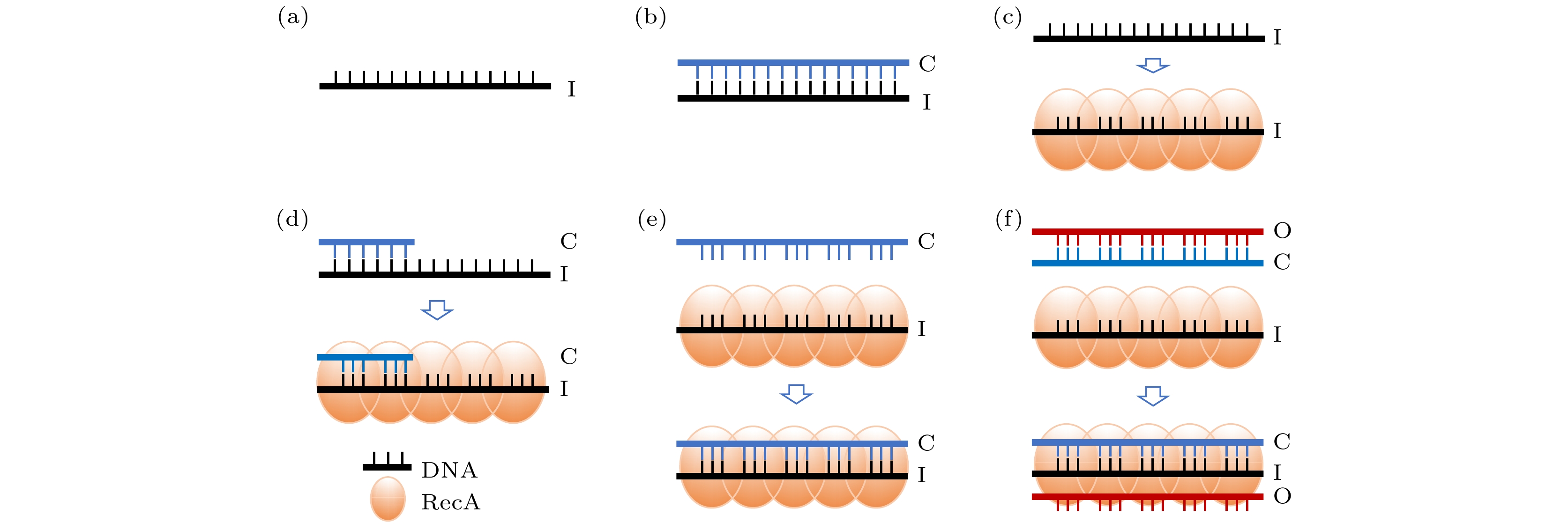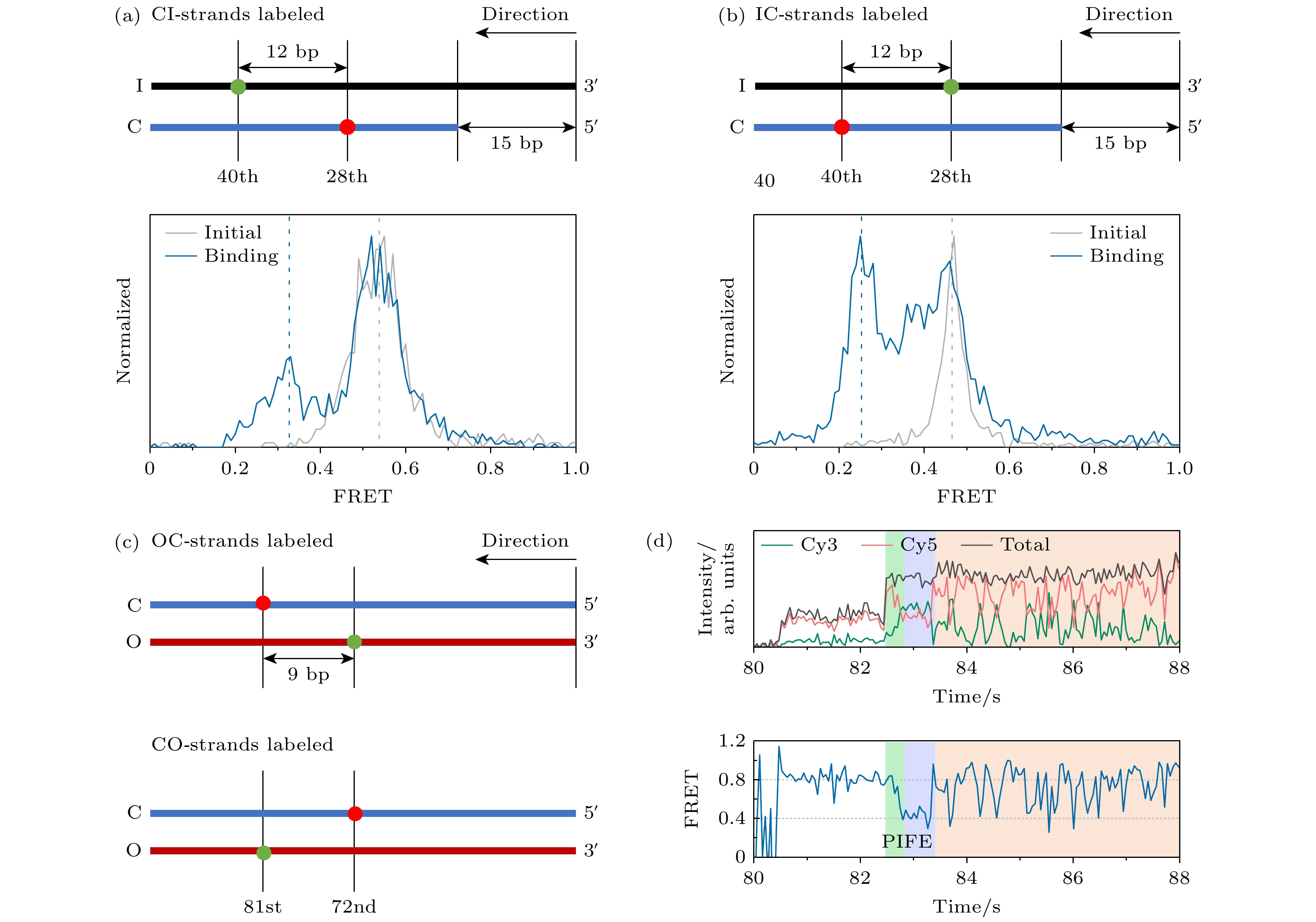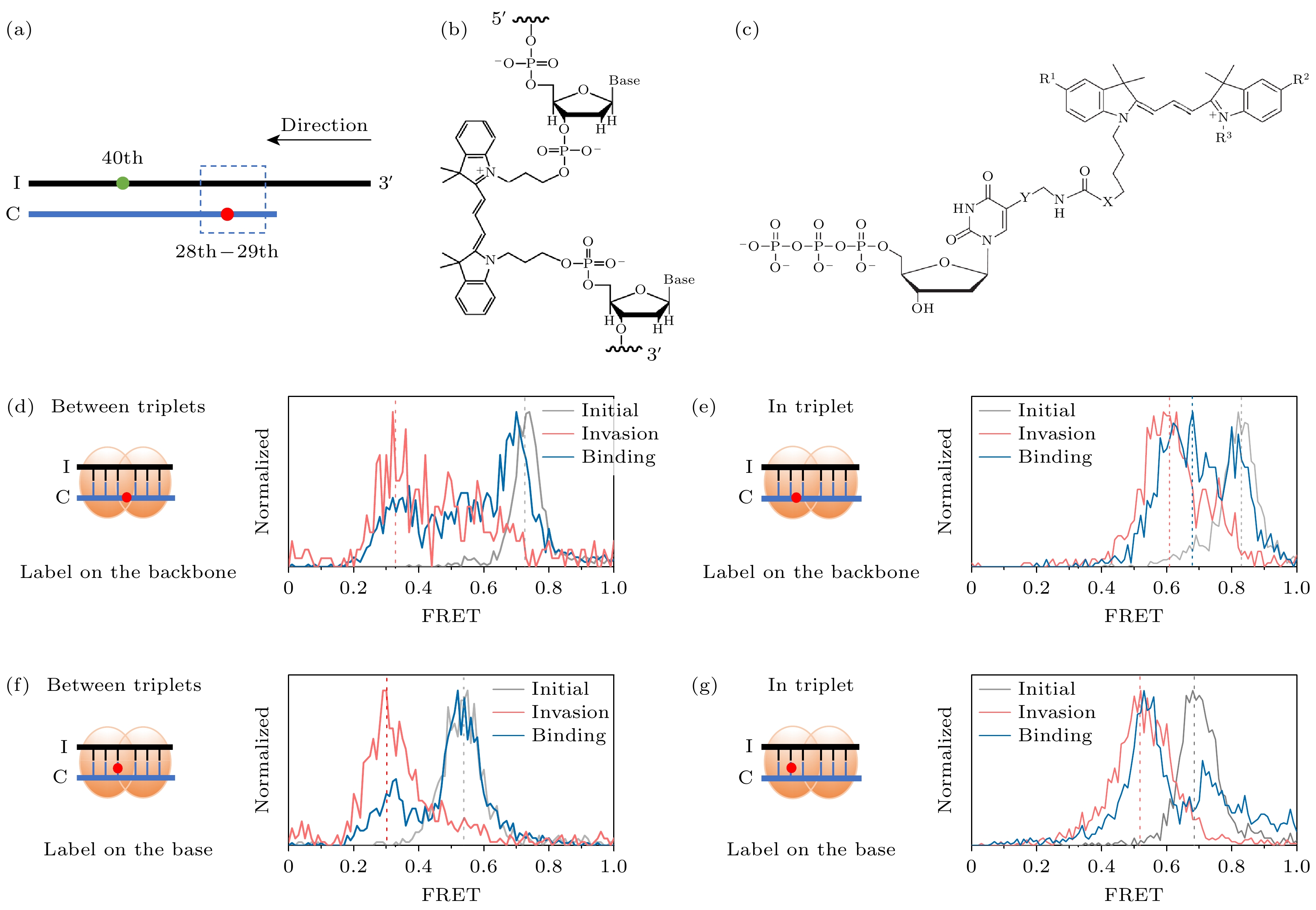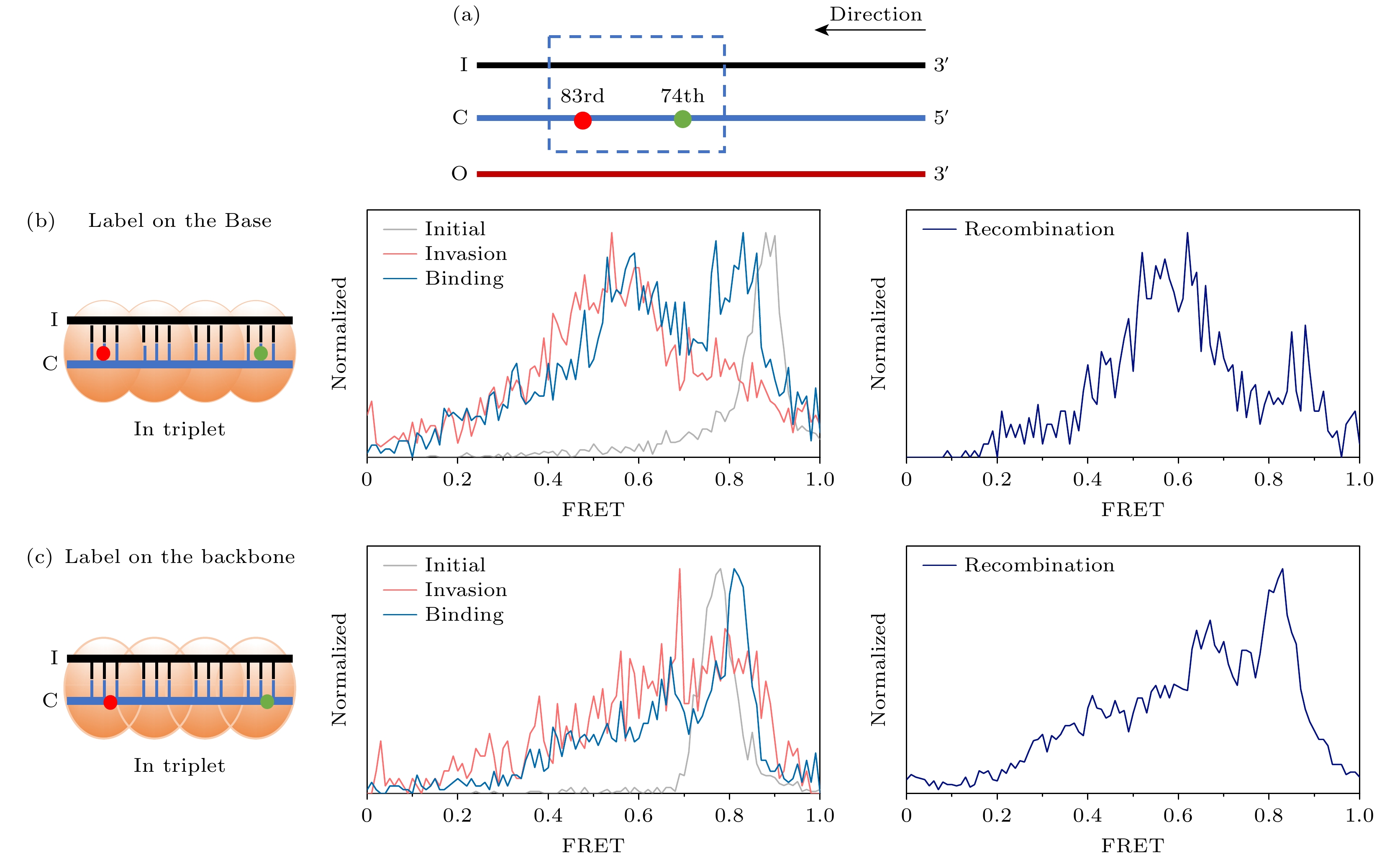-
Homologous recombination is a central mechanism for maintaining genome stability and biodiversity. RecA, as the first discovered homologous recombinase, plays a crucial role in homologous recombination strand exchange. In recent years, with the development of structural biology, significant breakthroughs have been made in understanding the static structure of the RecA nucleoprotein filament. However, research on the kinetic process of homologous recombination strand exchange mediated by RecA continues to encounter significant challenges. Research into the dynamic process has been ongoing for decades. In recent years, the use of single-molecule techniques has resulted in significant breakthroughs in this field. Among these techniques, single-molecule fluorescence resonance energy transfer (FRET) technology is widely used due to its ultra-high temporal and spatial resolution, making it well suitable for studying RecA-mediated homologous recombination strand exchange. However, the fluorescent labels required for FRET experiments may affect the RecA-mediated strand exchange process, which is often overlooked by researchers. Most of related articles focus on the effect of fluorescent labels on local structure. This paper primarily examines the effect of DNA fluorescent labeling on protein function, focusing on its effects on strand exchange from two perspectives: strand specificity and conformational sensitivity of the fluorescent labeling. Using experiments such as double-strand binding, single-strand invasion, and strand exchange, we develop a labeling scheme with the minimal effect—9 bp spaced C-strand double-base labeling in triplet— that can effectively improve the efficiency of studying the homologous recombination process. This result enhances the understanding of the effect of fluorescent labeling, allowing researchers to rapidly optimize the position and method of fluorescent labeling, and reduce its negative effects on the strand exchange process. Moreover, it provides some inspirations for other fluorescent labeling experiments.
-
Keywords:
- homologous recombination /
- RecA /
- single-molecule FRET /
- fluorescent labeling
[1] Kowalczykowski S C, Dixon D A, Eggleston A K, Lauder S D, Rehrauer W M 1994 Microbiol. Rev. 58 401
 Google Scholar
Google Scholar
[2] Prentiss M, Prévost C, Danilowicz C 2015 Crit. Rev. Biochem. Mol. Biol. 50 453
 Google Scholar
Google Scholar
[3] Roca A I, Cox M M 1990 Crit. Rev. Biochem. Mol. Biol. 25 415
 Google Scholar
Google Scholar
[4] West S C, Howard-Flanders P 1984 Cell 37 683
 Google Scholar
Google Scholar
[5] Yang H, Zhou C, Dhar A, Pavletich N P 2020 Nature 586 801
 Google Scholar
Google Scholar
[6] Danilowicz C, Feinstein E, Conover A, Coljee V W, Vlassakis J, Chan Y L, Bishop D K, Prentiss M 2012 Nucleic Acids Res. 40 1717
 Google Scholar
Google Scholar
[7] Mäeots M E, Lee B, Nans A, Jeong S G, Esfahani M M N, Ding S, Smith D J, Lee C S, Lee S S, Peter M, Enchev R I 2020 Nat. Commun. 11 3465
 Google Scholar
Google Scholar
[8] Hertzog M, Perry T N, Dupaigne P, Serres S, Morales V, Soulet A L, Bell J C, Margeat E, Kowalczykowski S C, Le Cam E, Fronzes R, Polard P 2023 Nucleic Acids Res. 51 2800
 Google Scholar
Google Scholar
[9] Chen J, Tang Q N, Guo S W, Lu C, Le S M, Yan J 2017 Nucleic Acids Res. 45 10032
 Google Scholar
Google Scholar
[10] Axelrod D 1984 J. Lumin. 31–32 881
 Google Scholar
Google Scholar
[11] Groves D, Hepp C, Kapanidis A N, Robb N C 2023 Quart. Rev. Biophys. 56 e3
 Google Scholar
Google Scholar
[12] Kim S H, Ragunathan K, Park J, Joo C, Kim D, Ha T 2014 J. Am. Chem. Soc. 136 14796
 Google Scholar
Google Scholar
[13] Ragunathan K, Liu C, Ha T 2012 eLife 1 e00067
 Google Scholar
Google Scholar
[14] Yu F Z, Zhang D B, Zhao C P, Zhao Q, Jiang G B, Wang H L 2023 Nucleic Acids Res. 51 2270
 Google Scholar
Google Scholar
[15] Kim S H, Joo C, Ha T, Kim D 2013 Nucleic Acids Res. 41 7738
 Google Scholar
Google Scholar
[16] Joo C, McKinney S A, Nakamura M, Rasnik I, Myong S, Ha T 2006 Cell 126 515
 Google Scholar
Google Scholar
[17] Garavís M, Escaja N, Gabelica V, Villasante A, González C 2015 Chem. Eur. J. 21 9816
 Google Scholar
Google Scholar
[18] Cox J M, Tsodikov O V, Cox M M 2005 PLoS Biol. 3 e52
 Google Scholar
Google Scholar
[19] 黄星榞, 隋明宇, 侯文清, 李明, 陆颖, 徐春华 2020 物理学报 69 208706
 Google Scholar
Google Scholar
Huang X Y, Sui M Y, Hou W Q, Li M, Lu Y, Xu C H, 2020 Acta Phys. Sin. 69 208706
 Google Scholar
Google Scholar
[20] Roy R, Hohng S, Ha T 2008 Nat. Methods 5 507
 Google Scholar
Google Scholar
[21] Peacock-Villada A, Yang D, Danilowicz C, Feinstein E, Pollock N, McShan S, Coljee V, Prentiss M 2012 Nucleic Acids Res. 40 10441
 Google Scholar
Google Scholar
[22] Huang X Y, Lu Y, Wang S, Sui M Y, Li J H, Ma J B, Ma D F, Jia Q, Hu S X, Xu C H, Li M 2020 Proc. Natl. Acad. Sci. U. S. A. 117 20549
 Google Scholar
Google Scholar
[23] Zasedateleva O A, Vasiliskov V A, Surzhikov S A, Kuznetsova V E, Shershov V E, Guseinov T O, Smirnov I P, Yurasov R A, Spitsyn M A, Chudinov A V 2018 Nucleic Acids Res. 46 e73
 Google Scholar
Google Scholar
[24] Chen Z, Yang H, Pavletich N P 2008 Nature 453 489
 Google Scholar
Google Scholar
[25] Heussman D, Kittell J, Von Hippel P H, Marcus A H 2022 J. Chem. Phys. 156 045101
 Google Scholar
Google Scholar
[26] Jahnke K, Grubmüller H, Igaev M, Göpfrich K 2021 Nucleic Acids Res. 49 4186
 Google Scholar
Google Scholar
[27] Cutler J I, Zhang K, Zheng D, Auyeung E, Prigodich A E, Mirkin C A 2011 J. Am. Chem. Soc. 133 9254
 Google Scholar
Google Scholar
[28] Cavaco M, Pérez-Peinado C, Valle J, Silva R D M, Correia J D G, Andreu D, Castanho M A R B, Neves V 2020 Front. Bioeng. Biotechnol. 8 552035
 Google Scholar
Google Scholar
[29] Yin L L, Wang W, Wang S P, Zhang F N, Zhang S T, Tao N J 2015 Biosens. Bioelectron. 66 412
 Google Scholar
Google Scholar
-
图 1 实验过程示意图 (a) ssDNA; (b) dsDNA; (c)单链缠绕实验; (d)双链缠绕实验; (e)单链入侵实验; (f)链交换实验; 其中黑色链为I链、蓝色链为C链、深红色链为O链、橙色椭圆为RecA蛋白
Figure 1. Schematic diagram of the experimental process: (a) ssDNA; (b) dsDNA; (c) single strand binding experiment; (d) double strand binding experiment; (e) single strand invasion experiment; (f) strand exchange experiment. The black strand is the I-strand, the blue strand is the C-strand, the red strand is the O-strand, the orange ellipse is the RecA protein.
图 2 链特异性实验 (a)上方为CI链标记位置示意图(其中绿色点为Cy3, 红色点为Cy5, 标记序列号为对应I链3' 端起始的碱基位置), 下方为CI链标记的初态FRET值统计图(灰色, Ncurve = 724)和双链缠绕FRET值统计图 (蓝色, Ncurve = 1360), 箭头表示双链缠绕的方向; (b)上方为IC链标记位置示意图, 下方为IC链标记的初态FRET值统计图(灰色, Ncurve = 516)和双链缠绕FRET值统计图(蓝色, Ncurve = 2546); (c) OC链标记(上)和CO链标记(下)示意图, 箭头表示链交换的方向; (d) OC链标记的典型链交换反应曲线, 其中红色线为Cy5光强, 绿色线为Cy3光强, 黑色线为总光强, 蓝色线为FRET值
Figure 2. Strand specificity experiment. (a) Schematic diagram of CI labeling positions at the top (where the green dot is Cy3 and the red dot is Cy5, and the labeled sequence number is the base position corresponding to the 3' end of the I-strand), and the statistical diagram of initial state FRET value of CI-strands labeling (gray, Ncurve = 724) and statistical diagram of double strand binding FRET value (blue, Ncurve = 1360) at the bottom, the arrow indicating double strand binding direction. (b) Schematic diagram of IC-strands labeling position at the top, and the statistical diagram of initial state FRET value of IC-strands labeling (gray, Ncurve = 516) and statistical diagram of double strand binding FRET value (blue, Ncurve = 2546) at the bottom. (c) Schematic diagram of OC-strands labeling (top) and CO-strands labeling (bottom), where the arrow shows the strand exchange direction. (d) A typical strand-exchange reaction trace labeled with OC strands, where the red line represents the light intensity of Cy5, the green line represents the light intensity of Cy3, the black line represents the total light intensity, and the blue line represents the FRET value.
图 3 标记位置与标记方式对比实验 (a) CI链标记位置示意图(其中绿色点为Cy3, 红色点为Cy5, 标记序列号为对应I链3' 端起始的碱基位置); (b)碱基标记Cy3分子结构式[23]; (c)骨架标记Cy3分子结构式[25]; (d) triplets之间骨架标记, 以及其B-DNA (灰色, Ncurve = 895)、单链入侵(红色, Ncurve = 1017)、双链缠绕(浅蓝, Ncurve = 2392)实验终态FRET值统计图; (e) triplet内部骨架标记, 以及其B-DNA(灰色, Ncurve = 694)、单链入侵(红色, Ncurve = 2238)、双链缠绕(浅蓝, Ncurve = 3543)实验终态FRET值统计图; (f) triplets边缘碱基标记, 以及其B-DNA(灰色, Ncurve = 895)、单链入侵(红色, Ncurve = 2797)、双链缠绕(浅蓝, Ncurve = 2339)实验终态FRET值统计图; (g) triplet中间碱基标记的B-DNA(灰色, Ncurve = 935)、单链入侵(红色, Ncurve = 2341)、双链缠绕(浅蓝, Ncurve = 2346) FRET值统计图, (d), (e), (f), (g)左侧示意图为(a)方框处的局部放大图
Figure 3. Comparison experiments of labeling positions and labeling methods: (a) Schematic diagram of CI-strand labeling positions (where the green dot is Cy3 and the red dot is Cy5, and the labeled sequence number is the base position corresponding to the 3' end of the I-strand); (b) molecular structural formula of base labeled Cy3[23]; (c) molecular structural formula of backbone labeled Cy3[25]; (d) statistical diagram of initial state FRET value of the B-DNA with backbone labeling between triplets (gray, Ncurve = 895), final state FRET value of single strand invasion (red, Ncurve = 1017) and double strand binding (light blue, Ncurve = 2392); (e) statistical diagram of initial state FRET value of the B-DNA with backbone labeling in triplets (gray, Ncurve = 694), final state FRET value of single strand invasion (red, Ncurve = 2238) and double strand binding (light blue, Ncurve = 3543); (f) statistical diagram of initial state FRET value of the B-DNA with base labeling between triplets (gray, Ncurve = 895), final state FRET value of single strand invasion (red, Ncurve = 2797) and double strand binding (light blue, Ncurve = 2339); (g) statistical diagram of initial state FRET value of the B-DNA with base labeling in triplets (gray, Ncurve = 935), final state FRET value of single strand invasion (red, Ncurve = 2341) and double strand binding (light blue, Ncurve = 2346); the left-side diagrams of (d), (e), (f), and (g) are enlarged views of the area marked in the box in (a).
图 4 C链双标记实验 (a)标记位置示意图(其中绿色点为Cy3, 红色点为Cy5, 标记序列号为对应I链3' 端起始的碱基位置); (b) C链骨架双标记放大图(左), 其B-DNA(灰色, Ncurve = 674)、单链入侵(红色, Ncurve = 987)、双链缠绕(浅蓝色, Ncurve = 3606)FRET值统计图(中)和链交换(深蓝色, Ncurve = 684)FRET值统计图(右); (c) C链碱基双标记放大图(左), 其B-DNA(灰色, Ncurve = 974)、单链入侵(红色, Ncurve = 1495)、双链缠绕(浅蓝色, Ncurve = 1618) FRET值统计图(中)链交换(浅蓝色, Ncurve = 597)FRET值统计图(右)
Figure 4. C-strand double labeling experiment. (a) Schematic diagram of labeling position (where the green dot is Cy3 and the red dot is Cy5, and the labeled sequence number is the base position corresponding to the 3' end of the I-strand). (b) Enlarged view of the C-strand backbone double labeling (left). Statistical diagram of its initial state FRET value of the B-DNA (gray, Ncurve = 674), final state FRET value of single strand invasion (red, Ncurve = 987), and double strand binding (light blue, Ncurve = 3606) (middle). Strand exchange (deep blue, Ncurve = 684) FRET (right). (c) Enlarged view of the double C-strand base labeling (left). Statistical diagram of its initial state FRET value of the B-DNA (gray, Ncurve = 974), final state FRET value of single strand invasion(red, Ncurve = 1495), double strand binding (light blue, Ncurve = 1618) (middle). And strand exchange(deep blue, Ncurve = 597) FRET (right).
-
[1] Kowalczykowski S C, Dixon D A, Eggleston A K, Lauder S D, Rehrauer W M 1994 Microbiol. Rev. 58 401
 Google Scholar
Google Scholar
[2] Prentiss M, Prévost C, Danilowicz C 2015 Crit. Rev. Biochem. Mol. Biol. 50 453
 Google Scholar
Google Scholar
[3] Roca A I, Cox M M 1990 Crit. Rev. Biochem. Mol. Biol. 25 415
 Google Scholar
Google Scholar
[4] West S C, Howard-Flanders P 1984 Cell 37 683
 Google Scholar
Google Scholar
[5] Yang H, Zhou C, Dhar A, Pavletich N P 2020 Nature 586 801
 Google Scholar
Google Scholar
[6] Danilowicz C, Feinstein E, Conover A, Coljee V W, Vlassakis J, Chan Y L, Bishop D K, Prentiss M 2012 Nucleic Acids Res. 40 1717
 Google Scholar
Google Scholar
[7] Mäeots M E, Lee B, Nans A, Jeong S G, Esfahani M M N, Ding S, Smith D J, Lee C S, Lee S S, Peter M, Enchev R I 2020 Nat. Commun. 11 3465
 Google Scholar
Google Scholar
[8] Hertzog M, Perry T N, Dupaigne P, Serres S, Morales V, Soulet A L, Bell J C, Margeat E, Kowalczykowski S C, Le Cam E, Fronzes R, Polard P 2023 Nucleic Acids Res. 51 2800
 Google Scholar
Google Scholar
[9] Chen J, Tang Q N, Guo S W, Lu C, Le S M, Yan J 2017 Nucleic Acids Res. 45 10032
 Google Scholar
Google Scholar
[10] Axelrod D 1984 J. Lumin. 31–32 881
 Google Scholar
Google Scholar
[11] Groves D, Hepp C, Kapanidis A N, Robb N C 2023 Quart. Rev. Biophys. 56 e3
 Google Scholar
Google Scholar
[12] Kim S H, Ragunathan K, Park J, Joo C, Kim D, Ha T 2014 J. Am. Chem. Soc. 136 14796
 Google Scholar
Google Scholar
[13] Ragunathan K, Liu C, Ha T 2012 eLife 1 e00067
 Google Scholar
Google Scholar
[14] Yu F Z, Zhang D B, Zhao C P, Zhao Q, Jiang G B, Wang H L 2023 Nucleic Acids Res. 51 2270
 Google Scholar
Google Scholar
[15] Kim S H, Joo C, Ha T, Kim D 2013 Nucleic Acids Res. 41 7738
 Google Scholar
Google Scholar
[16] Joo C, McKinney S A, Nakamura M, Rasnik I, Myong S, Ha T 2006 Cell 126 515
 Google Scholar
Google Scholar
[17] Garavís M, Escaja N, Gabelica V, Villasante A, González C 2015 Chem. Eur. J. 21 9816
 Google Scholar
Google Scholar
[18] Cox J M, Tsodikov O V, Cox M M 2005 PLoS Biol. 3 e52
 Google Scholar
Google Scholar
[19] 黄星榞, 隋明宇, 侯文清, 李明, 陆颖, 徐春华 2020 物理学报 69 208706
 Google Scholar
Google Scholar
Huang X Y, Sui M Y, Hou W Q, Li M, Lu Y, Xu C H, 2020 Acta Phys. Sin. 69 208706
 Google Scholar
Google Scholar
[20] Roy R, Hohng S, Ha T 2008 Nat. Methods 5 507
 Google Scholar
Google Scholar
[21] Peacock-Villada A, Yang D, Danilowicz C, Feinstein E, Pollock N, McShan S, Coljee V, Prentiss M 2012 Nucleic Acids Res. 40 10441
 Google Scholar
Google Scholar
[22] Huang X Y, Lu Y, Wang S, Sui M Y, Li J H, Ma J B, Ma D F, Jia Q, Hu S X, Xu C H, Li M 2020 Proc. Natl. Acad. Sci. U. S. A. 117 20549
 Google Scholar
Google Scholar
[23] Zasedateleva O A, Vasiliskov V A, Surzhikov S A, Kuznetsova V E, Shershov V E, Guseinov T O, Smirnov I P, Yurasov R A, Spitsyn M A, Chudinov A V 2018 Nucleic Acids Res. 46 e73
 Google Scholar
Google Scholar
[24] Chen Z, Yang H, Pavletich N P 2008 Nature 453 489
 Google Scholar
Google Scholar
[25] Heussman D, Kittell J, Von Hippel P H, Marcus A H 2022 J. Chem. Phys. 156 045101
 Google Scholar
Google Scholar
[26] Jahnke K, Grubmüller H, Igaev M, Göpfrich K 2021 Nucleic Acids Res. 49 4186
 Google Scholar
Google Scholar
[27] Cutler J I, Zhang K, Zheng D, Auyeung E, Prigodich A E, Mirkin C A 2011 J. Am. Chem. Soc. 133 9254
 Google Scholar
Google Scholar
[28] Cavaco M, Pérez-Peinado C, Valle J, Silva R D M, Correia J D G, Andreu D, Castanho M A R B, Neves V 2020 Front. Bioeng. Biotechnol. 8 552035
 Google Scholar
Google Scholar
[29] Yin L L, Wang W, Wang S P, Zhang F N, Zhang S T, Tao N J 2015 Biosens. Bioelectron. 66 412
 Google Scholar
Google Scholar
Catalog
Metrics
- Abstract views: 1613
- PDF Downloads: 37
- Cited By: 0















 DownLoad:
DownLoad:



